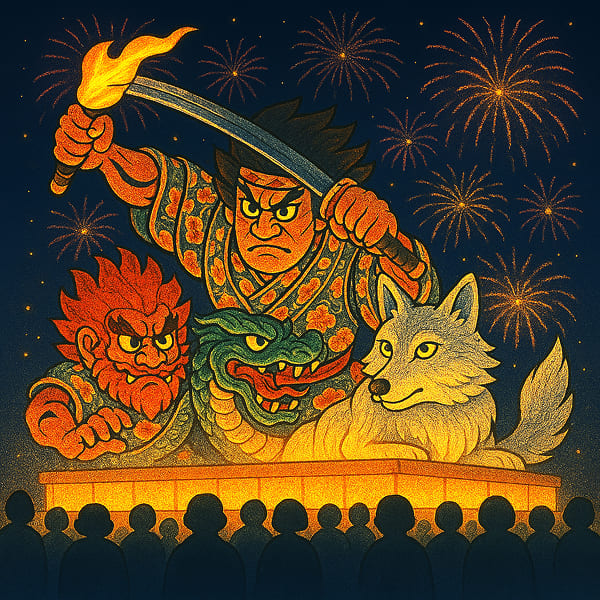Aomori Nebuta Festival: Japan’s Iconic Summer Lantern Parade in Tohoku

Contents
What if a city could come alive with glowing giants, pulsing drums, and dancers shouting into the summer night?
Every August, Aomori City transforms into a dazzling world of light and sound during the Aomori Nebuta Festival—one of the most electrifying and unforgettable Japanese summer festivals.
With over two million visitors drawn in by the hypnotic rhythm of taiko drums, the vibrant leap of Haneto dancers, and the towering brilliance of Nebuta floats, this Tohoku festival is more than an event—it’s an explosion of tradition, artistry, and communal spirit.
Step into the heart of Aomori travel season and discover a celebration where Japanese culture, mythology, and dynamic performance merge into one spectacular experience.
Spectacular Nebuta Floats and Energetic Dancers
At the heart of the festival are the enormous illuminated floats known as Nebuta, intricately crafted with colorful washi paper and lit from within.
These dynamic artworks depict legendary warriors, mythical creatures, and historical scenes from Japanese folklore and history.
The spectacle is accompanied by the rhythmic beats of taiko drums, the high-pitched sounds of bamboo flutes, and the shouts of Haneto dancers, who jump and chant “Rassera! Rassera!”—inviting everyone to join in.
Historical Roots: From Sleep-Purging Rituals to Cultural Celebration
The origins of the Nebuta Festival trace back to ancient Nemuri Nagashi rituals, where lanterns were floated down rivers to drive away sleepiness and bad spirits during the agricultural season.
Over time, it evolved into Nebuta Nagashi and Nebuta Asobi, blending with Chinese lantern traditions and local spiritual customs in the Tsugaru region.
By the mid-Edo period, warrior-themed parades were already popular. The addition of electric lights during the Meiji and Taisho eras modernized the floats, leading to today’s world-renowned Japanese cultural event.
The Meaning Behind “Nebuta”
The word Nebuta is believed to derive from the regional dialect nebuta(i), meaning sleepy—a reference to the festival’s early purpose of warding off drowsiness and revitalizing energy.
Though its exact etymology is debated, the festival continues to symbolize seasonal renewal, spiritual cleansing, and cultural pride in northern Japan.
Modern Day Nebuta: A Fusion of Art and Heritage
Today’s Aomori Nebuta Festival showcases around 15 enormous floats, each designed with a unique theme based on:
- Japanese mythology
- Historical heroes
- Contemporary social messages
These stunning creations are brought to life by skilled artisans called Nebuta-shi, who spend months crafting them by hand using traditional techniques passed down through generations.
The final night culminates in the Nebuta Marine Parade, where the floats sail through the bay under a sky filled with fireworks—a breathtaking finale.
Fun Facts and Cultural Highlights
- Recognized as an Important Intangible Folk Cultural Property of Japan
- Has been featured internationally in countries such as the U.S., France, and China
- Still aims for UNESCO Intangible Cultural Heritage status (as of 2025)
- The word "Rassera!" is unique to this festival and symbolizes inclusion and energy
How to Experience the Aomori Nebuta Festival
If you’re planning to attend one of the most spectacular summer events in Japan, here’s what you need to know:
- Location: Aomori City, Aomori Prefecture (northern Honshu)
- Dates: Annually from August 2 to August 7
- Main Venue: Around Shinmachi Street and Aomori Bay area
Access
- By Train: Take the JR Tohoku Shinkansen to Shin-Aomori Station, then transfer to Aomori Station (5 minutes)
- By Air: Fly into Aomori Airport, then take a shuttle to the city center (approx. 35 minutes)
Tips for Visitors
- Arrive early to secure a good viewing spot
- Rent or wear a Haneto costume to join the parade!
- Book accommodations months in advance due to high demand
- Combine your trip with visits to Hakkoda Mountains, Nebuta Museum Wa Rasse, or Hirosaki Castle
Best Time to Visit Aomori
- August 2–7: Peak of the Nebuta Float Parade
- Early August: Warm weather, local food stalls, fireworks
- Late Summer: Great time to explore nearby Tohoku countryside
Final Thoughts
Whether you're fascinated by Japanese traditional arts, looking for an unforgettable festival experience, or simply exploring Tohoku travel destinations, the Aomori Nebuta Festival delivers a feast for all senses.
Glowing giants, vibrant music, and cultural passion—this is summer in Japan at its most spectacular.
So when you plan your next trip to Japan, don't miss the chance to witness Nebuta magic lighting up the night sky.